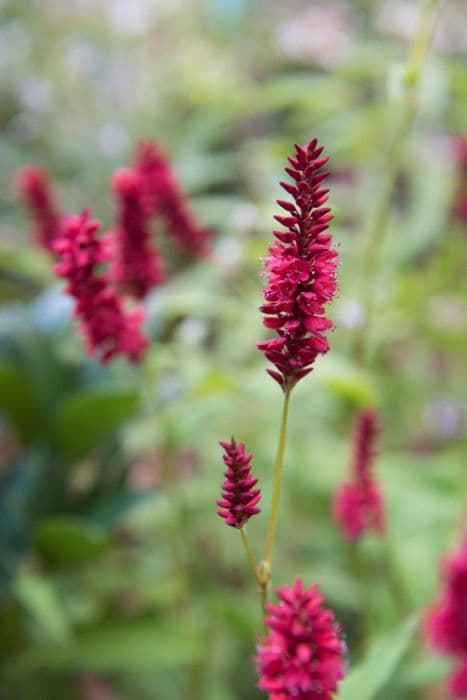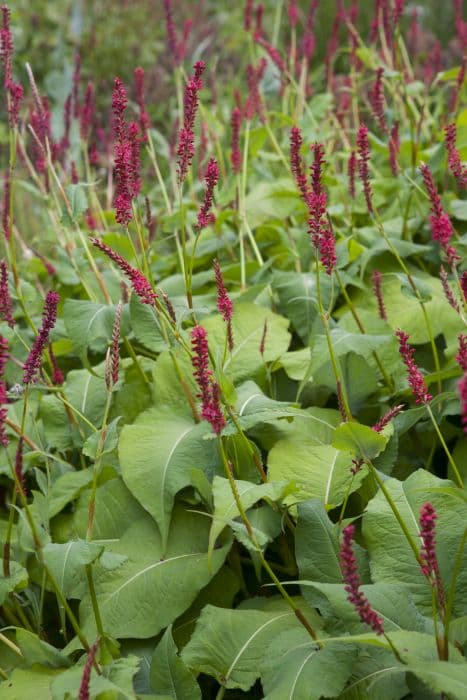Red bistort Persicaria amplexicaulis 'Atrosanguinea'

ABOUT
The Persicaria amplexicaulis 'Atrosanguinea', commonly known as Red Bistort or Mountain Fleece, is a visually striking perennial plant with distinguishing features that make it a popular choice for ornamental gardens. The plant displays a lush green, clump-forming foliage base composed of large, elongated leaves that provide a dense backdrop for its most notable characteristic, the spikes of tiny, densely packed flowers. These flowers are rich in color, typically a deep, dark red or sometimes a deep pink, hence the name 'Atrosanguinea' which suggests a dark blood-red hue. The individual blooms are shaped like little funnels and are tightly arranged on slender, upright spires that arise elegantly above the leafy mound. The stems holding the flower spires are slender and often have a reddish tint which adds to the plant's overall aesthetic appeal. The blooming period for Red Bistort usually spans from mid-summer to early fall, during which the flowering spires create a striking contrast against the green foliage and attract various pollinators such as butterflies and bees. Overall, the Red Bistort is known for its robust character and the vibrant pop of color it brings to garden settings, making it an attractive choice for borders or as a focal point in planting schemes. Its aesthetic appeal lies in the combination of its leafy green base and the eye-catching flower spires that present a dramatic yet graceful display.
About this plant
 Names
NamesFamily
Polygonaceae
Synonyms
Red Bistort, Mountain Fleece, Knotweed
Common names
Persicaria amplexicaulis 'Atrosanguinea'.
 Toxicity
ToxicityTo humans
The Red Bistort, as Persicaria amplexicaulis is commonly known, is not typically listed as a poisonous plant to humans. However, as with many plants that are not commonly used for food, it is always possible for certain individuals to have a reaction or sensitivity to the plant. If ingested, symptoms would likely be mild and could include gastrointestinal discomfort, such as nausea or vomiting. It's always best to err on the side of caution and avoid ingesting parts of ornamental plants due to potential unknown toxic properties or individual allergies.
To pets
For pets, Red Bistort is also not commonly listed as a toxic plant. However, pets can also have individual sensitivities and allergic reactions to plants that are not typically harmful to humans. If a pet were to ingest parts of this plant, symptoms of poisoning may manifest as mild gastrointestinal upset, including vomiting or diarrhea. To prevent any possible adverse effects, it is a good practice to keep pets away from ornamental plants and to consult a veterinarian if any suspicion of plant ingestion occurs.
 Characteristics
CharacteristicsLife cycle
Perennials
Foliage type
Deciduous
Color of leaves
Green
Flower color
Red
Height
3-4 feet (0.9-1.2 meters)
Spread
2-3 feet (0.6-0.9 meters)
Plant type
Herb
Hardiness zones
5
Native area
Himalayas
Benefits
 General Benefits
General Benefits- Attracts Pollinators: 'Atrosanguinea' is known to attract bees, butterflies, and other beneficial insects that are essential for pollination.
- Long Blooming: This variety typically has a long flowering season, providing color and interest in the garden from mid-summer through to fall.
- Low Maintenance: Once established, it requires minimal maintenance, making it a good choice for busy gardeners or those looking for low-care landscapes.
- Drought Tolerance: It can cope well with short periods of drought once it is established, reducing the need for frequent watering.
- Hardiness: This plant is hardy in a range of conditions and can withstand cold winters in many climate zones.
- Aesthetic Appeal: With its lush foliage and richly colored flowers, 'Atrosanguinea' adds visual appeal to borders, beds, and cottage gardens.
- Erosion Control: The dense growth habit can help to prevent soil erosion on banks and slopes.
 Medical Properties
Medical PropertiesThis plant is not used for medical purposes.
 Air-purifying Qualities
Air-purifying QualitiesThis plant is not specifically known for air purifying qualities.
 Other Uses
Other Uses- Persicaria amplexicaulis 'Atrosanguinea', commonly known as Bistort, can be used for natural fabric dyeing, imparting a range of colors from yellows to browns, depending on the mordant used.
- In the garden, Bistort serves as an excellent ground cover in shady areas to suppress weeds due to its dense foliage.
- The flowers of Bistort can be used for ornamental purposes such as flower arrangements or dried for crafts due to their unique shape and color.
- Bistort can be planted along stream banks for erosion control, as it has a fibrous root system that stabilizes soil.
- The plant can be used as an educational tool for botany and horticulture students, as it exhibits interesting growth and propagation characteristics.
- It can be a source of nectar for bees and butterflies, supporting local pollinator populations within a garden ecosystem.
- When included in a wildlife-friendly garden, Bistort's seeds provide food for finches and other seed-eating birds during autumn and winter.
- Due to its vigorous growth, it can be used to fill gaps in the landscape quickly, providing a cost-effective solution for large garden spaces.
- Bistort can act as a backdrop plant in floral displays or gardening competitions, showcasing plants of shorter stature in the foreground.
- For artistic purposes, its unique shape and color can inspire designs in textiles, prints, and garden pottery creations.
Interesting Facts
 Feng Shui
Feng ShuiThe Red Bistort is not used in Feng Shui practice.
 Zodiac Sign Compitability
Zodiac Sign CompitabilityThe Red Bistort is not used in astrology practice.
 Plant Symbolism
Plant Symbolism- Connection: The Persicaria amplexicaulis, commonly known as "Mountain Fleece," with its dense clusters of flowers, symbolizes the interwoven nature of relationships, suggesting a strong connection between individuals or within a community.
- Resilience: Given its ability to thrive in various challenging conditions, Mountain Fleece embodies resilience and the capacity to overcome obstacles.
- Growth: The vigorous growth habit of this plant signifies personal or professional development and the importance of continuous learning and adaptation.
- Protection: This plant can create a lush barrier when massed together, implying a sense of protection and safety in numbers.
 Water
WaterRed bistort requires consistent moisture, so it is important to water regularly. During the growing season, water when the top inch of soil feels dry, providing about 1 to 2 gallons per week depending on weather conditions. Increased watering may be necessary during prolonged periods of heat or drought. Be sure to avoid overhead watering to prevent foliar diseases. During winter, reduce watering as the plant requires less moisture when dormant.
 Light
LightRed bistort thrives best in full sun to partial shade. It can tolerate full sun in cooler climates but prefers some afternoon shade in hotter regions. Ideally, situate the plant in a spot where it receives morning sunlight and some protection from the intense heat of the afternoon.
 Temperature
TemperatureRed bistort prefers a temperature range from 50°F at night to 80°F during the day. It can tolerate a minimum temperature of around 40°F but should not be exposed to hard frosts or prolonged freezing temperatures. The ideal temperature for vigorous growth would be consistently above 50°F without extreme fluctuations.
 Pruning
PruningPrune red bistort in late winter or early spring to remove dead foliage and encourage new growth. Cut back the plant to about 3-6 inches from the ground annually. Additional deadheading of spent flowers during the growing season can promote further blooming and maintain a tidy appearance.
 Cleaning
CleaningAs needed
 Soil
SoilMountain Fleece, or Persicaria amplexicaulis 'Atrosanguinea', thrives in a soil mix that's rich in organic matter with good drainage. A mixture of garden soil, compost, and a bit of sand or perlite to improve drainage would be ideal. This plant prefers a slightly acidic to neutral pH, ranging from 6.0 to 7.0.
 Repotting
RepottingMountain Fleece generally does not require frequent repotting, as it is a hardy perennial. It should be divided or repotted once every 3-5 years to maintain vigor and to prevent overcrowding within the garden space.
 Humidity & Misting
Humidity & MistingMountain Fleece is adaptable to a wide range of humidity conditions and does well in the average outdoor humidity found in its hardiness range. It does not require any special humidity conditions to grow successfully.
 Suitable locations
Suitable locationsIndoor
Provide bright light; keep soil consistently moist.
Outdoor
Plant in moist soil; partial to full sun exposure.
Hardiness zone
4-7 USDA
 Life cycle
Life cycleThe Persicaria amplexicaulis 'Atrosanguinea', commonly known as Red bistort, begins its life cycle when seeds germinate in the spring, given appropriate moist soil conditions and temperatures. The seedlings develop true leaves and progressively form a clump of foliage at the base, as well as a robust root system. Over the following months, the plant matures and produces long, slender stems topped with dense spikes of small, deep red flowers, typically from early summer to late autumn. After the flowering period, seeds are set and dispersed, which can germinate to create new plants, or the plant can spread vegetatively through underground rhizomes. In the winter, the above-ground part of the plant dies back, while the roots or rhizomes enter a period of dormancy. The following spring, the plant regrows from the existing rootstock, resuming the cycle.
 Propogation
PropogationPropogation time
Late Spring
The most popular method for propagating Persicaria amplexicaulis 'Atrosanguinea', also known as Red bistort or Mountain fleece, is by division. This is typically done in the spring as the plants start to emerge from dormancy. To propagate by division, carefully lift the clump from the ground using a garden fork, trying to minimize root damage. Once the clump is out of the ground, it can be divided into several smaller sections, ensuring that each section has a portion of the root system attached. These divisions should then be replanted at the same depth they were originally growing, spaced about 18 to 24 inches (approximately 45 to 60 centimeters) apart to allow adequate room for growth. The soil should be kept moist until the new divisions have established themselves and resumed normal growth.









